CSA Farm Newsletter Week 8 (Aug 13-19, 2023)
Farm Newsletter Week 8
August 13-19, 2023 | “B” Week
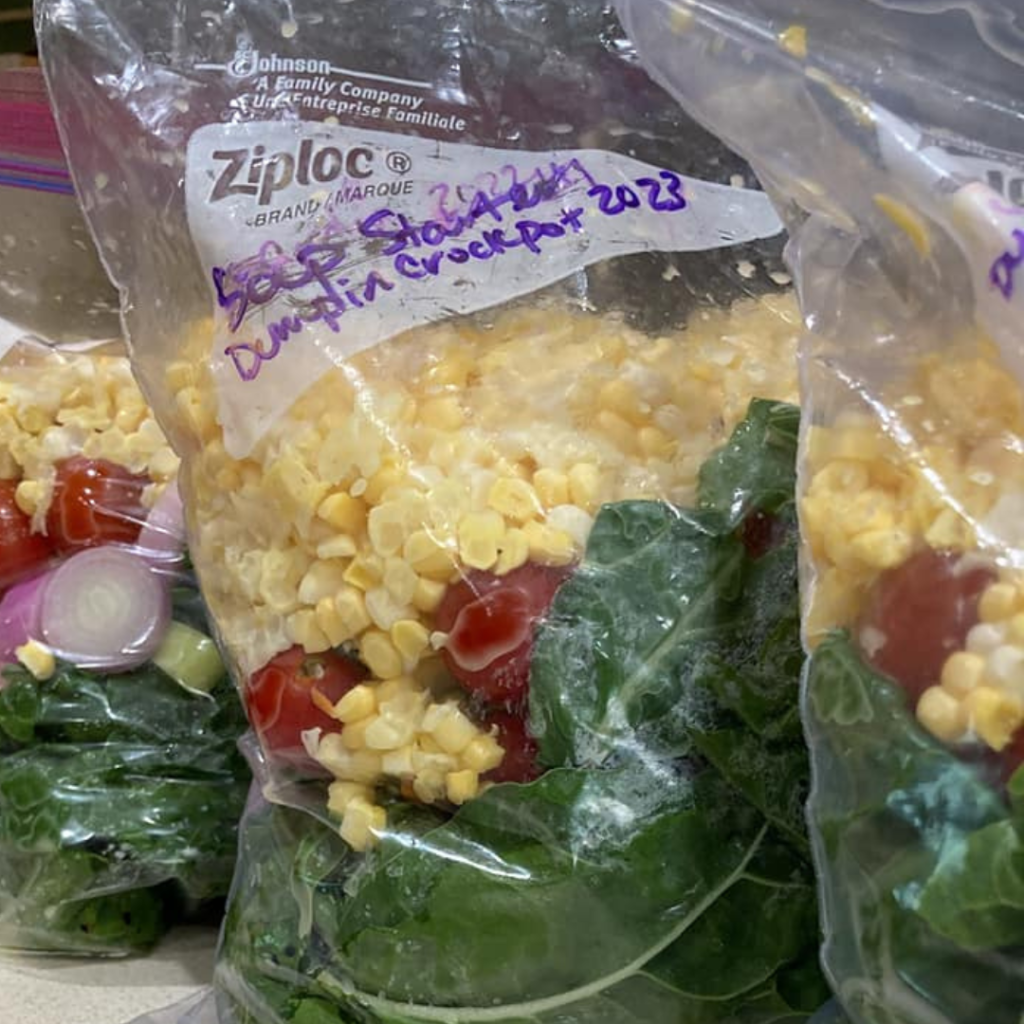
The Freezer Soup Starter Bag Challenge is in full swing. Lots of great entries are happening in the Facebook group this week. This picture came from Cindy Butler. Be sure to enter to win!
What’s in the Box this Week?
HEAD LETTUCE (CRISP HEAD) ~ To store: Store unwashed lettuce in a plastic bag in the refrigerator. To store lettuce that you have already washed and dried with a spinner, place back in a plastic bag with a dry paper towel in the bag, and place the package in the vegetable crisper bin. Use within 4 days. To prep: Slice the head at its base with a knife and let the leaves fall open. Discard any damaged or leathery outer leaves and tear large leaves into bite-size pieces. Wash leaves in a basin of cold water. Dry in a salad spinner.
RED GLOBE TOMATOES (2) ~ To store: Do not refrigerate tomatoes. Store them at room temperature out of the sun stem side down. Putting them in a paper bag will accelerate the ripening process. To prep: If you’ll be cooking tomatoes, consider removing the skins so they don’t float around in your dish. To do so, score the end of the tomato with an “X,” dunk whole tomatoes in boiling water for 30 seconds, lift out with slotted spoon, plunge into ice water, and the skins will slide off. To freeze: Tomatoes can be frozen whole with the skin on. The skins will slide right off when they thaw. Simply pop the washed tomatoes whole into a Ziplock bag. Thawed tomatoes are appropriate only for cooking sauces, salsas, or purees.
HEIRLOOM TOMATO (1) ~ Heirlooms are known for their flavor, but they have a VERY small shelf life, so eat them on the first day. You’ll also see cracks and scarring on these tomatoes. This is normal. To store: Do not refrigerate tomatoes. Store them at room temperature out of the sun stem side down.
SWEET CORN (6 ears) ~ (not organic, non-GMO, from David Bench Farms) ~ To store: Refrigerate sweet corn as soon as possible with husks on. The longer you wait to eat it, the more sugar will turn into starch, and the corn will lose its \ sweetness. To prep: You can eat corn raw or cook it in the husks. Shuck the cob by pulling the husks down the ear and snapping off the stem. The silks will fall off as you cook the corn. Rinse under cold water. If you see a green worm, just cut out the damaged section — the rest of the cob is still edible! To cut the kernels off the cob, stand the cob upright on its base and run a sharp knife from the tip of the ear down to the base. To cook: Steam corn in 1-2 inches of water for 6-10 minutes, or drop ears into boiling water for 3-6 minutes. Season with butter or salt. You can also grill corn in the husk — place the corn in its husk in water for 10 minutes — then place on grill for 15 minutes. To freeze: Blanch on the cob for 3-5 minutes, rinse under cold water, and drain. Cut off the kernels with a knife, and then pack it into airtight freezer containers.
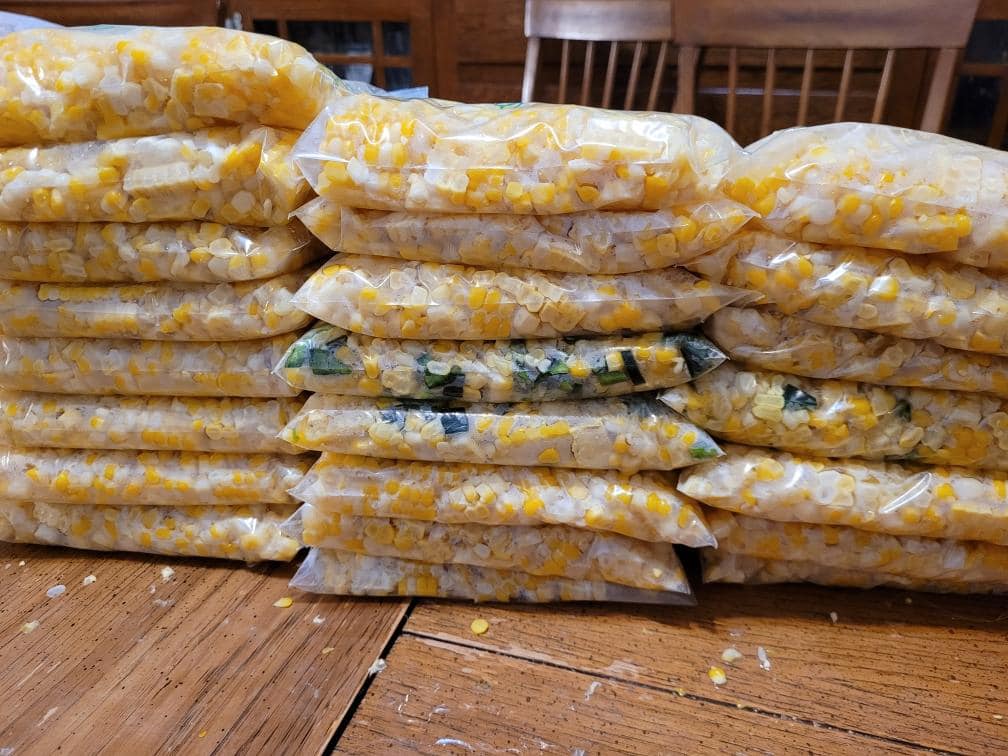
Alyssa Baker froze 70 ears of corn this past week. Are you freezing a bulk bag?
SUMMER SQUASH (3) ~ You will get some mix of summer squashes — could be green or yellow zucchini, yellow Zephyr crookneck, or patty pans. To store: Store squash unwashed in a perforated plastic bag in the vegetable bin. In the refrigerator they keep for about a week. To prep: Rinse under water to remove the dirt or prickles, and slice off the stem and blossom ends. Then slice or chop. Scrape out seeds from baseball bat sized zucchinis before using them to bake. To use: Slice tender, young summer squash raw into salads. Try them in stir-fry or with pasta. Lightly steam (4-5 minutes) and dress them with fresh herbs or pesto. Or coat squash lightly in oil and roast at 350 degrees whole or sliced in half for 15-45 minutes. Stuff whole squash with your favorite stuffings. Bread them and make zuke fries. To freeze: You can freeze grated zucchini for use in breads and muffins. Squeeze as much liquid out as possible before adding to the freezer bag.
YELLOW ONIONS ~ These onions have been cured, so you can store them in a cool, dark place — preferably not close to your potatoes. To prep: Peel the onion’s skin and cut off the roots and top. To freeze: Cut or slice onions to desired size and place in freezer Ziplock bag. Remove all the air and seal. It helps to freeze them in 2-3 cup increments.
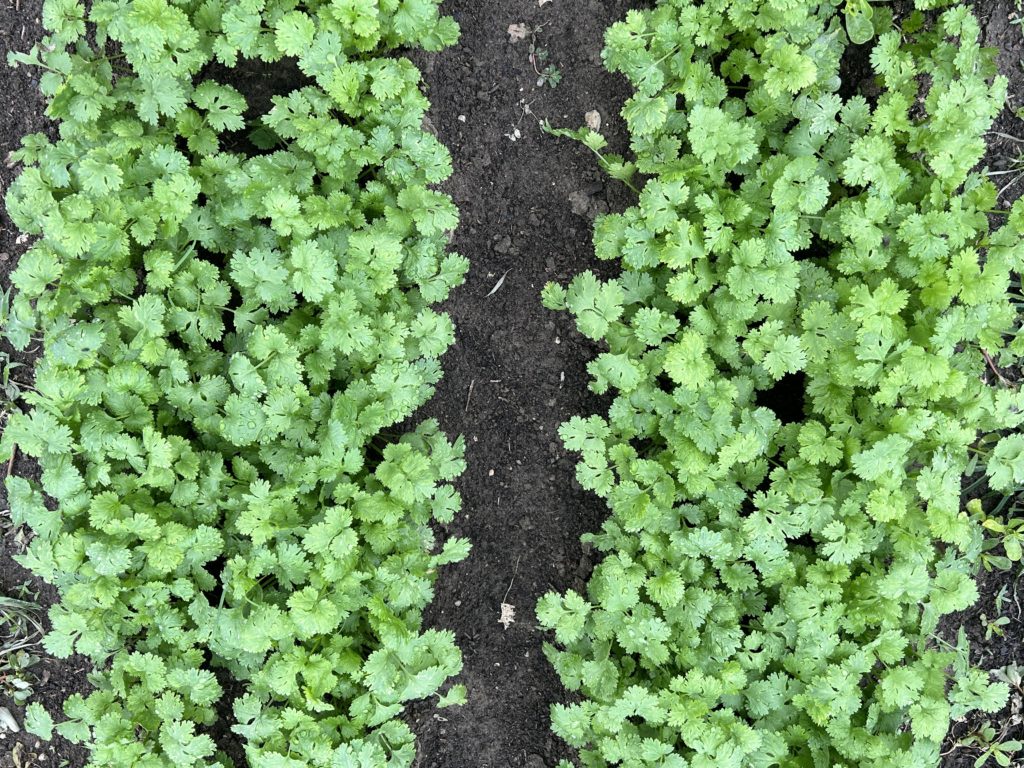
It is estimated that 4 to 14 percent of the U.S. population has a genetic variation, making cilantro taste like soap,
BUNCHED CILANTRO ~ Cilantro looks like parsley, but has a strong soapy smell and flavor. It is used in ethnic cuisine — Asian, Indian, and Mexican (especially salsa). Since it doesn’t stand up to heat, it is usually added to a dish right before serving. For short-term storage, stand upright in a container with an inch of water. Then cover the herbs loosely with a plastic bag and refrigerate for up to 2 weeks. To prep: Chop the stem and leaves with a butcher knife. The stems can be eaten too.
POTATOES (1 heaping quart ) from Mile Creek Farm ~ Keep unwashed potatoes in a cool, dark, dry place, such as a loosely closed paper bag in a cupboard. They will keep for two weeks at room temperature. Light turns them green, and proximity to onions causes them to sprout. Don’t put them in the refrigerator, as low temperatures convert the starch to sugars. To prep: Scrub well and cut off any sprouts or green skin. Peeling is a matter of preference. In soups, the skins may separate from the flesh and float in the broth, but when baked, pan- fried or roasted, the skins acquire a crisp, crunchy texture. To cook: Boil potatoes in water for 20-30 minutes until tender. If desired, mash them. Use potatoes in soups, hash browns, and salads. Roast sliced or whole small potatoes with fresh herbs, salt, and olive oil at 400 degrees until tender, about 20 minutes.
SHISHITO PEPPERS (5) ~ These peppers are fun! Roughly 1 out of 10 of them are hot! The rest taste like a regular pepper. So it’s a little bit like playing Russian Roulette. To store: Refrigerate peppers unwashed in a sealed plastic bag in the crisper drawer for 1-2 weeks. You can also dehydrate peppers for long-term. To freeze: Wash and dry. Keep whole, or cut into bite-size pieces and place in Ziplock freezer bag.
GREEN BELL PEPPERS (2) ~ To store: Refrigerate peppers unwashed in a sealed plastic bag in the crisper drawer for 1-2 weeks. To prep: Cut in half and remove the seeds from the inside. Slice, chop or mince. Try making stuffed peppers! (These can also be frozen). To freeze: Wash and dry peppers. Freeze whole or cut into bite-size pieces and place in Ziplock freezer bag, removing as much air as possible.
FLAVOR BURST BELL PEPPERS (2) ~ an early variety of bells, with a striking lime green skin. Use them like normal bells.
JALAPENO (1 or 2) ~ To store: Refrigerate peppers unwashed in a sealed plastic bag in the crisper drawer for 1-2 weeks. You can also dehydrate peppers for long-term. To prep: Be careful when preparing hot peppers of any kind. For greatest safety wear rubber gloves while chopping and handling them. Do not touch your eyes, nose, mouth or other places. Wash hands thoroughly when finished. Slice off the top of the hot pepper, including the stem. Since the heat in chili peppers is concentrated in the seeds and membranes, you can cut out the heat-filled seeds and membranes for a milder heat. To freeze: Wash and dry. Keep whole, or cut into bite-size pieces and place in Ziplock freezer bag.
CUSTOMER PHOTO OF THE WEEK!
This week’s photo goes to Michelle Perkins-Cole from the Perrysburg site. She showed a picture of kohlrabi on the spiralizer!! She named them “koodles.” I loved this reminder that we can use the spiralizer on all kinds of root or bulbous veggies. Thanks, Michelle for sharing your idea with our community and helping us get better at cooking!
WEEK 8 ADD-ON SHARES: We are Week “B”
Odd-numbered weeks of our CSA season (week 1,3,5) are called “A” weeks. And even-numbered weeks (week 2,4,6) are called “B” weeks. If you have any kind of non-veggie, bi-weekly share, you have been assigned to either “A” or “B” week for the season. If you get a cheese share, it always comes on Week “A.”
WEEK 9 FRUIT SHARE (not organic):
SUNFIRE PLUMS ~ (via Quarry Hill Orchard) – if these are hard as a rock, you’ll want to store them on the counter until they ripen. THEN put them in the fridge. These will have an orange-yellowish skin and are very sweet.
NECTARINEs ~ (via Quarry Hill Orchard) Store these on the counter until they are no longer hard. Then put in a bag in your fridge. Remove pit before eating, or eat out of hand.
WATERMELON (Bench Farms) ~ Wash the outer rind, and cut the fruit in half. Remove the seeds. Then cut into slices and eat out of hand. OR remove the rind and chunk up the fruit for your next fruit salad or dessert!
Ice Cream Flavor of the Week:
Blueberry Sweet Corn from Knueven Creamery. Note: be sure to stop and pick up your ice cream from the Knueven milk truck at your pickup site! They will be located either right before or after your veggie pickup. Your farmers will not be passing this out in their delivery line.
Coffee Flavor of the Week:
Guatemala Huehuetenango: Maddie & Bella Coffee Company stone fruit, caramelized sugar, tropical

Take the Shishito Challenge this week!
Take the Shishito Pepper Challenge!
August 13-19, 2023 | #shishitochallenge23
Have you ever heard of a Shishito pepper? These are fun members of the pepper family because roughly one out of 10 of them are spicy! It’s kind of like playing the lottery with a pepper. We’re including them in your CSA share for week 8! And to celebrate, we thought we’d have a little fun…
We’ve having a fun BONUS contest this week called the Shishito Pepper Challenge.
Here’s how it works: You will get 5 shishito peppers in your box. We dare you to try one and see if it is spicy! Just cut off a small portion and take a nibble. Then post your results in our Facebook group by snapping a picture of you eating the pepper OR a just picture of your nibbled pepper for proof! If you’re REALLY brave, and/or you have a lot of family members, you can give EACH of them a pepper to try, and see who gets the lucky one! Have some milk standing by in case you hit the jackpot!
To be clear: All you have to do to enter the contest is to post a picture of you trying ONE of your five peppers. It doesn’t have to be a hot one — any will do. Put the hashtag #shishitochallenge23 on the post so I can be sure to find it. I’ll choose one lucky random winner on August 20 from a bowl of names, and they’ll win a three-pack of Rowdy Rider sauce by Elmore local Jack Stolar.

Farmer Kurt discusses the cover crop seed research trial with operator.
FARMER KURT’S FIELD NOTES
This week was a sprint — with a big wholesale order to manage, in addition to the regular harvest workflow and planting of fall fennel. I still haven’t had a chance to install electric in the pack shed. Corinna keeps bugging me about that. Soon, it’ll be getting darker sooner, and my pack crew won’t be able to see anything in there. I’m having trouble finding an electrician to be able to come out — no one’s calling me back. I’ll try again this week. Something always works out.
Melon harvest also started this week –– so that’s another thing to fit into the workflow. The boys are a part of that process. They like to throw melons at each other — this is some rite of passage farm boys have. They accidentally conked Corinna in the head with a small one the other day while she was taking a photo — she wasn’t too happy. The cantaloupes are just outstanding this year — super sweet. I hope you enjoyed them. Yellow, orange, and red seedless watermelons got picked Wednesday, and people are clamoring for them already. I’ve got several big orders I’m managing for my parents to get out. I’m trying not to spend too much time in a delivery truck these days. Glen should be back in the saddle once school starts and he’ll be able to take that load off of me.
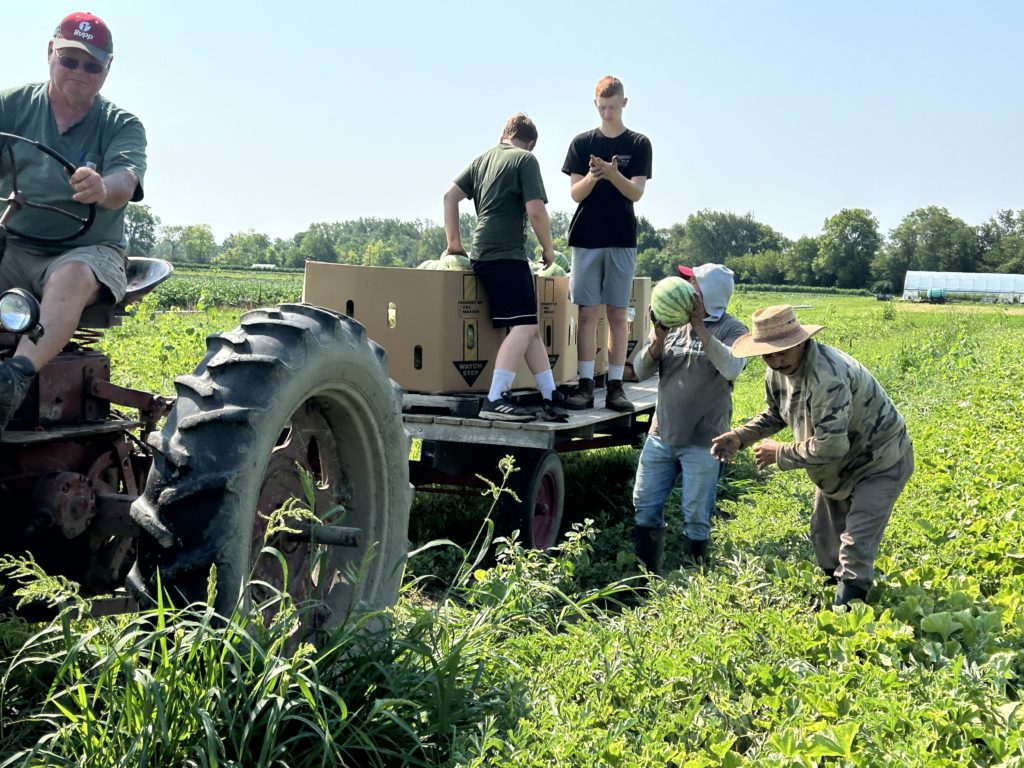
The crew harvests watermelons.
Daisy is in heat — she is digging holes, whining, clingy, and ripping up every piece of cardboard she can find.
The big rain predicted for last week didn’t ever materialize, so I’ve been irrigating off and on this week. Things are looking really good. Temperatures have been milder than usual this summer overall. I feel like we’re right in between the true start of summer crops and the end of spring — a bit of a lag in the crops transitioning. The amaranth I planted looks beautiful. This is a green I introduced last year, and everyone liked it. It’s billed a summer-hearty salad green, and it’s beautiful.
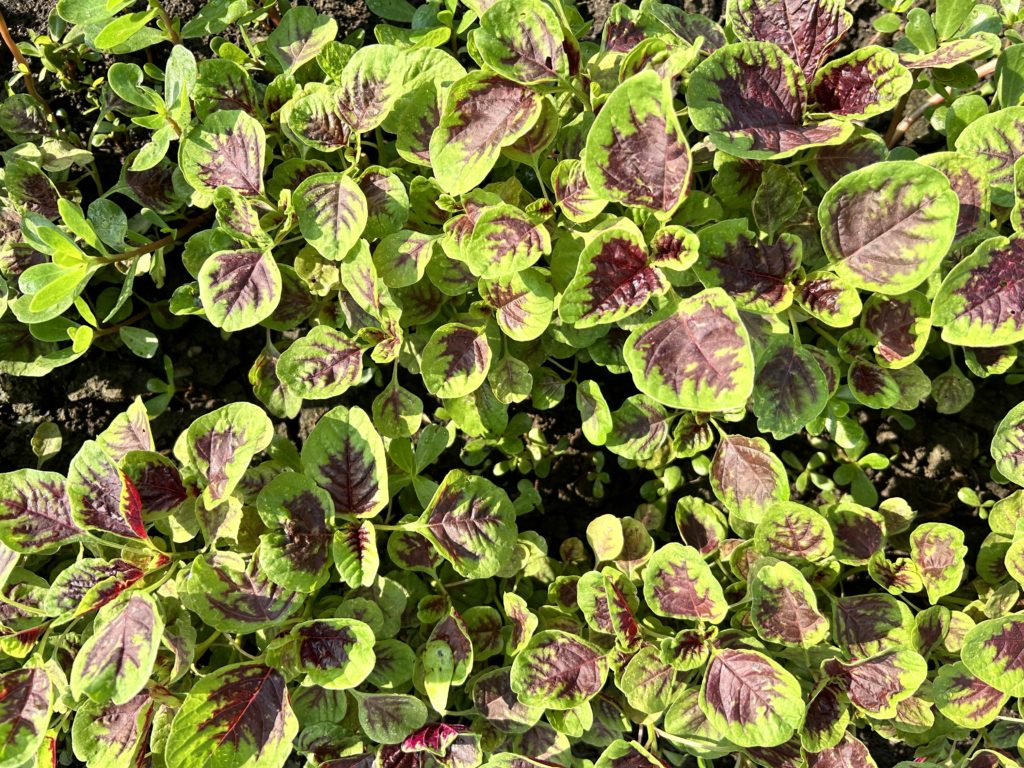
This is what amaranth looks like! Coming soon…
My new sprayer arrived this week. This was a $12,000 investment — one of the big capital purchases for our farm this year. I’ll be selling my old one to Clay Hill Farms. Remember: just because we’re an organic farm doesn’t mean we don’t spray. We just use sprays that are deemed safe. Pests and disease are a part of farming, and we have tools in our organic arsenal that help us fight them. I’ve got an article in this week’s blogpost all about “do organic farmers spray?” I want to make sure you are educated on this topic so you can help correct misconceptions out there.
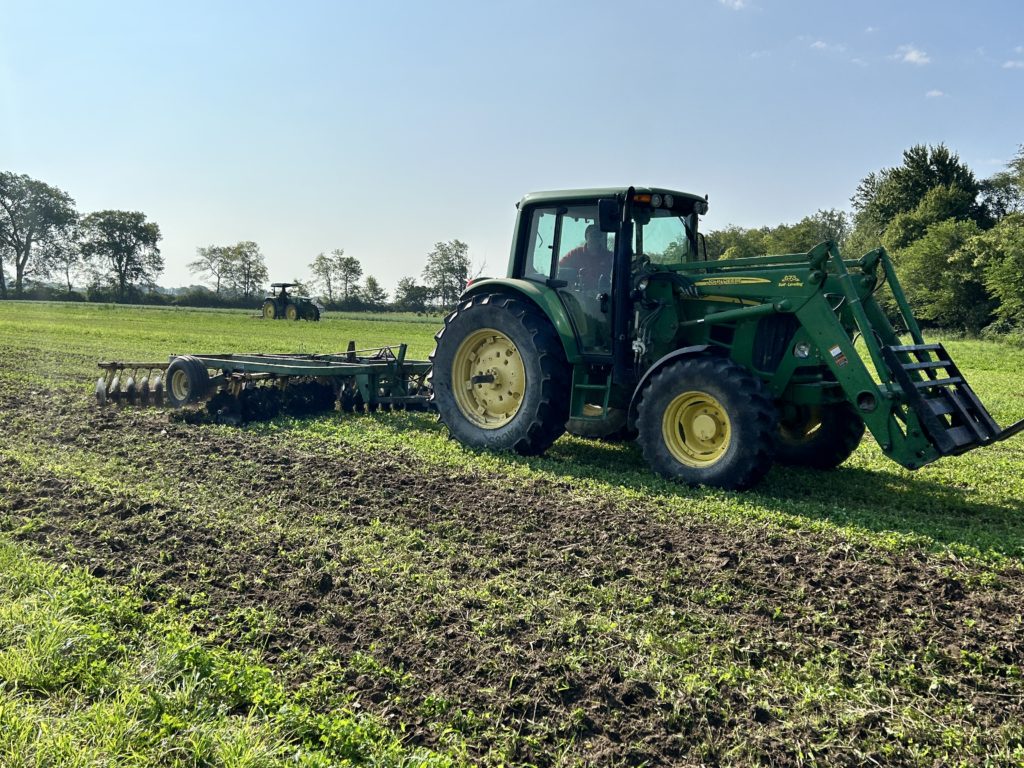
This tractor is disking up the ground, and a cover crop trial will be planted here.
Research trials at the farm. Some Ohio Extension agents were out to the farm this week, doing a research trial with cover crops in my fallow land. In one section they’re planting cover crops into ground that’s been disked. In another section, they’re planting cover crops using “no-till” — that means directly into the ground without disking it up. They want to see if the yields are better with no-till, and how much nitrogen needs to be added. It’s exciting to be a part of research trials as an organic farm. They’ll be able to use this data to make recommendations to other farmers for planting practices. Should farmers use no-till? Or continue with the practice of tilling first (and disturbing the soil bed)?
We hosted some “big wigs” from the Ohio CAN program, giving them a tour of our farm this past Wednesday. If you recall, last week I told you this program was established with the USDA AMS Local Food Purchase Assistance Program grant funds. The mission is to provide food to those in need. Through this program, producers like us are are able to sell food to the Ohio Association of Foodbanks at fair market price and the products will be distributed to Ohioans in need through food banks and charities across all 88 counties. We were able to tell these 10 representatives about how this program was helping our farm thrive in the form of money for capital investments (like a new cooler), and allowing us to put money back into local businesses.
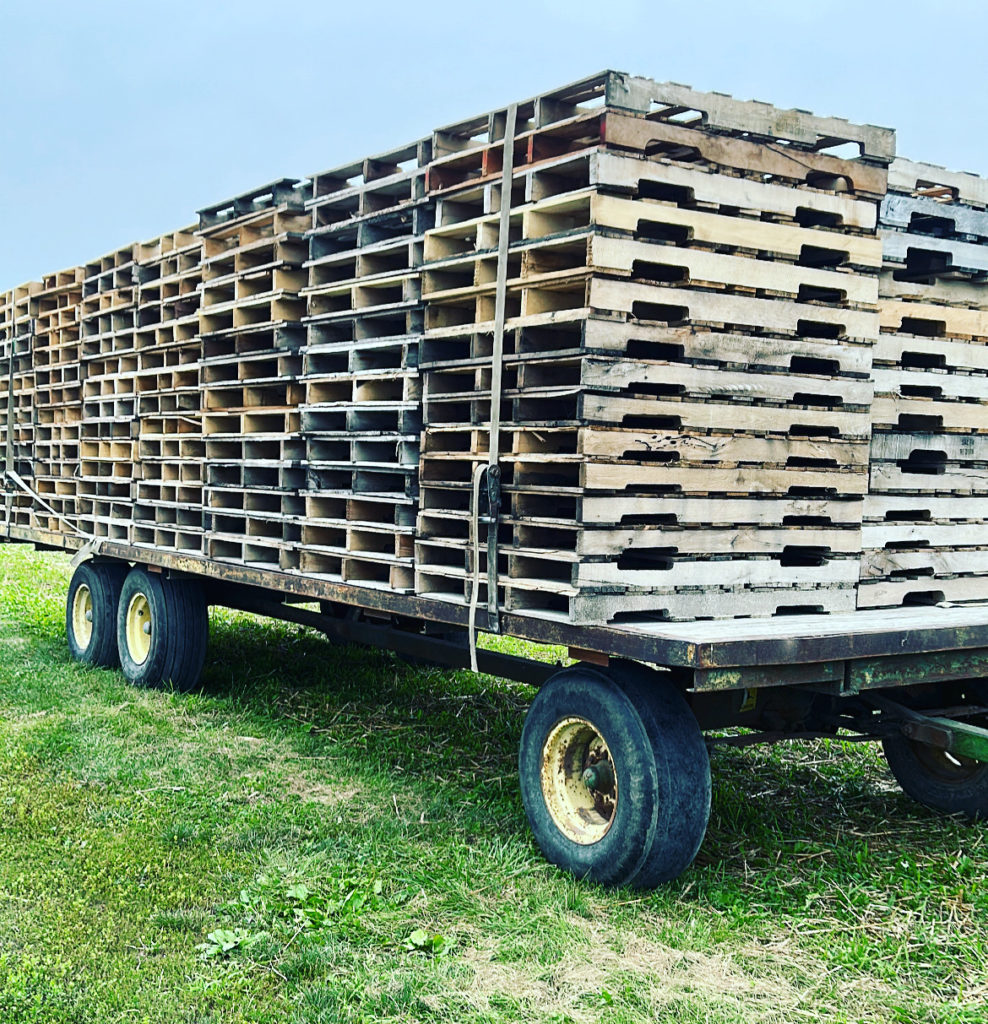
Corinna freaked out when she saw all these pallets show up on the farm this week. These will be used to help us deliver wholesale cabbage and peppers.
We had a big wholesale pepper order go out for this CAN program. My crew harvested 4000 pounds of peppers over 2 days — washed, packed, and delivered on Thursday! It was a very cool moment for us — to see how we are leading the way for other producers in the state on this project, and to realize that we are now a seasoned, mature farm business that can pull this off. We have another big order of peppers in two weeks, followed by some winter carrots and cabbage. In fact, I ordered an entire wagon of pallets in anticipation of these orders — about 280 in total. Not all of them are for us. I bought them on behalf of other partners in this CAN cooperative venture. But still, Corinna was a little concerned when she saw them. “Where are you going to put those,” she asked. I just smiled.

Winter squash is blooming.
Going tubing this Saturday at Argo Park with our friends, the Markleys. This is a place Corinna discovered a few years ago, that I don’t think too many people know about. It’s free — about 7 rapids with an easy walk-back trail to the beginning. We just bring our own tubes and fill them there at the rental place for free. We’ve been planning this for a while, but I never know if I’ll be able to get away. Jed told me this week, “You have to go, or I will kidnap you.” That’s when I realized I better make it a priority. Time goes fast, my friends. Show up for the important stuff.
~Your Farmer, Kurt
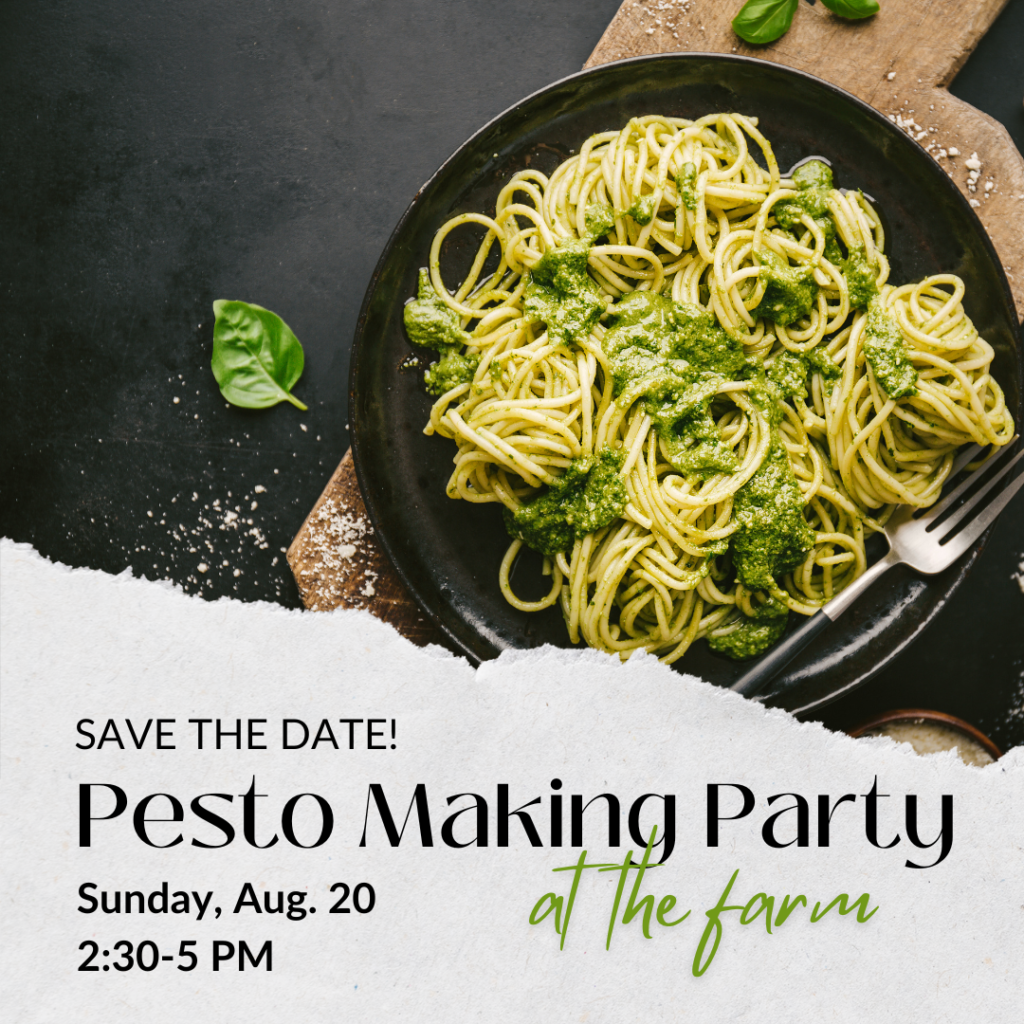
Pesto Fest is back!
RSVP FOR PESTO FEST
Make a ton of pesto on our farm to take home and freeze
Date: August 20, 2:30-5:30 PM.
Price: $10/person
Dinner begins around 4:30 PM
Here’s how it works: You bring a food processor, olive oil, nuts, cutting board, lemon juice, salt, Ziplock baggies, and chef’s knife. We provide the basil, “B-grade” garlic, tables, power strips and electric. We take you out to the basil patch to harvest your own basil. Take as much as you need, and come back to the packing shed area, where we set up tables (and electric outlets) for you to make your pesto until 4:30 PM. It’s a loud, garlicky fragrant time!
Meanwhile, I’m heating up a bunch of pasta for a light dinner!! Around 4:30 PM, we set up tables outside the pack shed, bring out the pasta, and taste a sample of each other’s creations. We ask you to bring a small portion of one of your pestos to the table to share. I make a nice tomato-basil salad with some garlic bread. And we enjoy some fellowship together.
This event is limited to 30 people. Cost is $10/person. Please order your tickets in the online store here. No refunds for cancellations or no-shows.
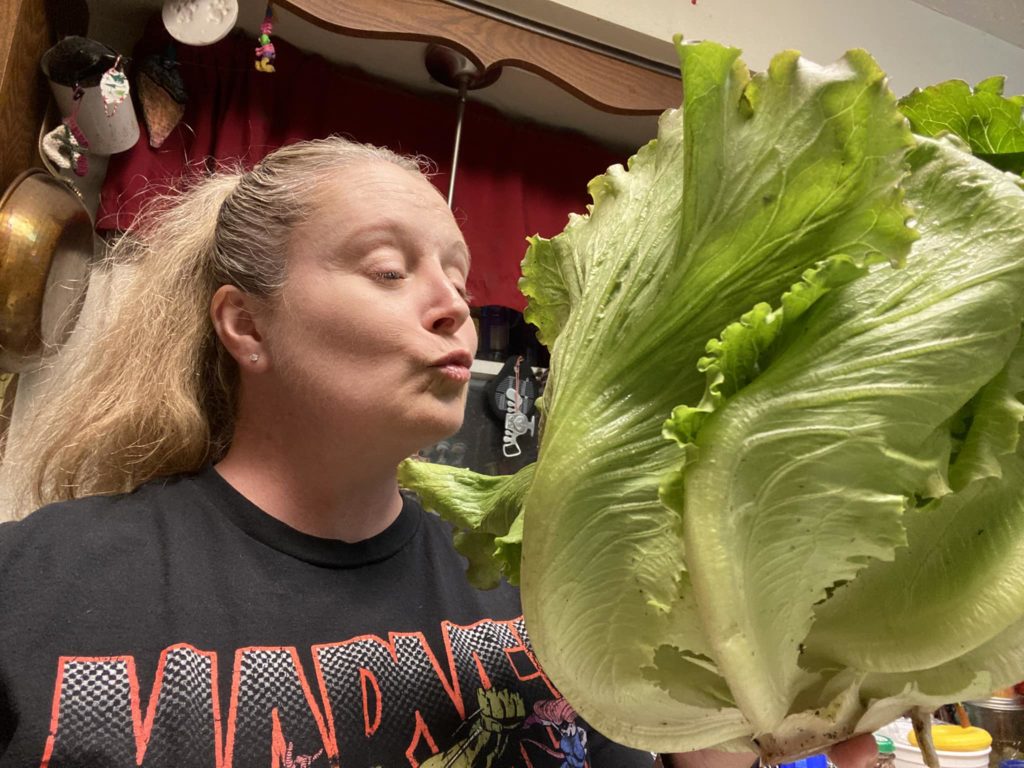
We couldn’t believe the size of last week’s lettuce.
WEEK 8 ANNOUNCEMENTS
- BULK CORN can be ordered in our online store. We’ll have this for the next 6 weeks. The best time to buy bulk corn is in August, when the ears are largest. A bushel bag goes for $35 and includes 64 ears. We only have a limited amount of space on our trucks, so if we sell out, just hang on tight and be ready to order next week. If you want to learn how to freeze sweet corn, watch our video tutorial here. I recommend the Corn Cutter from Pampered Chef (affiliate link) to make it a whole lot easier, as well as an angel food cake pan or bundt pan.
- You can order additional items from the Shared Legacy Farms online store. Our store link is super easy to remember: www.sharedlegacyfarms.com/store. Just be sure to select the right pickup site that coincides with your pickup location. If the pickup option is greyed out or not available, it means you missed the window to order. You need to place your order 36 hours before your site. We harvest the product on Monday and Wednesday mornings — early. This week, the store will have: sweet corn (by the bushel, or half dozen); red icebox watermelon (not organic); cantaloupe (not organic); carrots (no tops); head lettuce, cabbage, basil, kohlrabi, red beets (bulk or by the quart), golden beets, chioggia bulls-eye beets, tomatillos, shishito peppers (10 peppers); swiss chard, eggplant (two types), slicing tomatoes (4-pack); flower bouquets; yellow peaches (not organic).
- PESTO Fest is back, and includes a light dinner (where we sample each other’s creations)! Save the date for Sunday, August 20th. Join us from 2:30-5:30 PM in our packing shed. Order your tickets today in the online store for $10 each. Limit: 20 tickets.
- Can you volunteer to pack corn for us on a Monday or Wednesday evening for 2 hours this September? I’m currently looking for 3 more slots to fill. This involves bagging about 200 bags of corn (6 ears each) and placing them into a bin. It’s a good workout towards the end, and does involve reaching down into a bin repeatedly. Please let me know if you can help! This shaves about an hour of time off our packing crew’s job and gets them out on time!
- Want a one-time flower bouquet from Clay Hill Farm? Christy has some extra to sell us. So I’m loading in a few extra one-time bouquets into the online store this week. Grab a bonus bouquet for yourself or a friend! www.sharedlegacyfarms.com
 FREEZER SOUP STARTER BAG CHALLENGE!
FREEZER SOUP STARTER BAG CHALLENGE!
(Runs August 5-19, 2023)
Have you ever made a Freezer Soup Starter bag? These are a GREAT way to “get rid of” extra produce that is starting to stockpile in the kitchen. With a little guidance, you can just throw your raw veggies into a gallon-size freezer bag, and toss them in the freezer. I like to write a few instructions onto the bag to remind me what else to add later (like meat, water, juice, herbs, etc). Then, 3 months later, when it’s winter time, you can pull out a quick starter meal bag, and throw it in your soup pot or crockpot.
To encourage you to try this exit strategy, and get some freezer bags stored up for the winter, I’ve decided to run a contest for the next two weeks! It’s the Freezer Soup Bag Challenge.
To enter, all you have to do is make ONE freezer soup starter bag before August 19.
- Take a picture of it, and share the “recipe” in our CSA’s private Facebook group (or via email with your farmers).
- Be sure to tell us what you put into the bag, so we can build out the recipe. (Or link to it if you got it somewhere else)
- Give your soup a name, and tag it #freezersoupbagchallenge.
Note: you must be a CSA member to be eligible to win the prize.
You can enter as many times as you like in the 14 day period! Every different soup bag “style” counts as one entry, so the more entries you make, the greater your odds of winning. I will choose ONE person at random from the entries submitted on August 20 to win the prize!
THE PRIZE: Super-Soup Gift Basket — (I wish I could tell you exactly what’s in here, but I haven’t made it yet! I can’t wait to build this fun prize!) Value: $100
I’ll compile the collection of ideas from our community and put together a little Freezer Soup Recipe Book to share with you in a few weeks! So get creative! Show us what’s possible!
Please note: although you are always welcome to make soup this week and freeze the finished product, that’s not what this challenge is about. THIS challenge is about freezing the make-ahead ingredients/”starter kit” — we’re trying to make it as EASY as possible for you, so that LATER, you can pull this bag out and have a quick meal. So I want you to think of recipes that are “ingredient dump into a Ziplock” and freeze.

Do organic farmers spray? Yes, but using organic chemicals. Kurt got a new sprayer this week for our farm, which was a big investment for us.
Do Organic Farmers Spray? (YES, but…).
Organic Pest Management Revealed!
If you signed up for our CSA because we were “certified organic,” you may be wondering, how do you keep those bugs off? What exactly are you doing different?
This blogpost is designed to answer those questions. (Cuz I know you’re asking them).
The reality is that pest management is a necessity for every farmer. Why?…
Because no one likes finding flea beetles in their Napa cabbage or worms on their broccoli — (even gracious, accommodating CSA members).
Americans expect perfect produce.
Grocery store chains also have strict quality standards as a result. If our produce is scarred, misshapen, or marked with a few holes — it’s rejected. (I don’t blame them. They’re just delivering what their customer wants.)
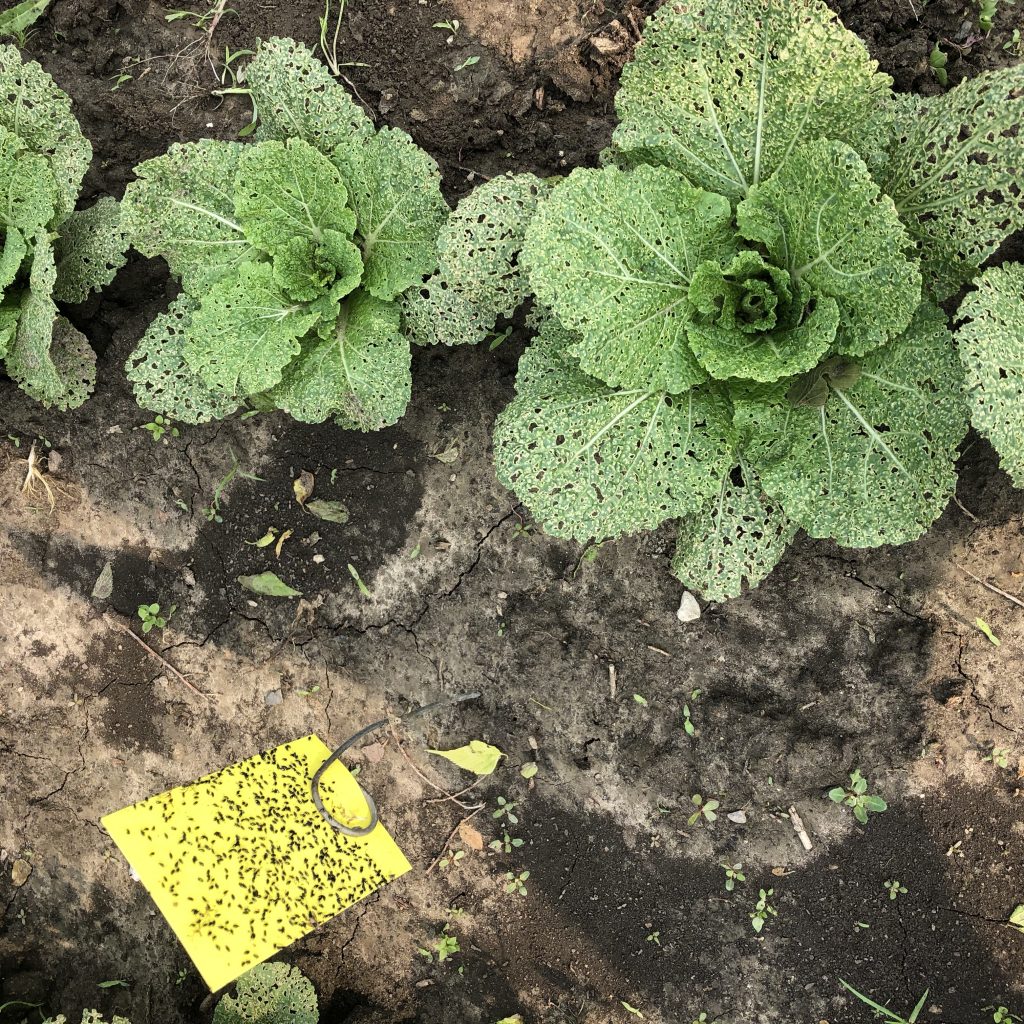
Would you want to eat this? Exactly. This is what happens when flea beetles get out of control. Pest management is a MUST for all farmers. Find out how we combat pests as organic farmers.
This week, I want to peel back the layers and educate you about how organic pest management works for us as organic growers.
I’m also going to bust a common myth — namely that certified organic farmers don’t spray.
Because we do.
Is your mind blowing up right now? And before you freak out, keep reading because there is WAY more to this story. I’ll spell it all out by the end of this article.
But first things first: Shared Legacy Farms has been certified organic since 2016.
That’s a big deal. And it’s not “easy” to do.
If you see the “USDA Organic” or “Certified Organic” seal on your food, it means that: they are free of synthetic additives like pesticides, chemical fertilizers, and dyes, and must not be processed using industrial solvents, irradiation, or genetic engineering, according to the USDA.

The certified organic seal
To keep our certified status, we have to abide by these rules.
That means there are certain growing practices that are flat out NOT ALLOWED. Many of them revolve around:
- what you can and cannot do to amend your soil,
- what you can and cannot spray on your plants, (there’s that scary word again) — and
- what kinds of seeds you can and cannot use (i.e. no GMOs ever).
We must also document everything we do — from seed varieties and yields per bed row, to compost applications, to wash water concentrations, to soil testing results, to every chemical we spray on our plants. And once a year, a 3rd party inspector comes to the farm and spends several hours grilling Farmer Kurt — all in an attempt to verify that our documentation and practices match the certified organic “standard.”
So let’s talk about those bugs.
Bugs like to feast on our plants.
It’s what they do.
And we can’t take it personally. They’re just trying to survive.
They’ll either eat the leaves and roots, which stunts the plant’s growth and causes it to go into defense mode, or they’ll eat the vegetable itself!
Every farm has a list of top 5 bug offenders. Our pests include thrips (for onions), flea beetles, cucumber beetles, cabbage looper worm, and the Colorado potato beetle.
As certified organic growers, we have several tools in our arsenal for combatting bugs. Here’s a brief summary of the more common ones we use…
8 Organic Preventive Measures for Bugs:
Promoting healthy soil — Farmer Kurt likes to say, “Healthy soil produces healthy plants.” We focus a lot of our energy on the front end trying to build up our soil health BEFORE we ever plant. Cover crops, cow manure, chicken manure, fish fertilizer, molasses, nematodes, mineralization. The theory is that if your soil is balanced, it will create stronger plants with the energy to fight pests off when they come (or at least minimize their damage).
Knowing Bug Life Cycles — So all bugs follow a life cycle. For example, the adult potato beetle lives about 30 days and spends its 4 weeks laying batches of orange eggs on the underside of the leaves. These hatch after 4-10 days into larva. The larva feed for 21 days. They then fall into the soil and form a pupa. They emerge 5-10 days later as an adult, and start the whole process over again. If you know the different phases of the pest’s development, you can create counter-measures to attack them when they are most vulnerable. Or at the very least, you might know when you have a period of relief in bug pressure.

This reflective poly is also a bug deterrant. It disorients the pest known as “thrips” and keeps their population down.
Plastic Mulch — Have you seen any of our pictures of the plastic row covering on our beds? We sometimes use a reflective kind — it looks like aluminum foil. This shiny surface disorients certain bugs and significantly decreases the number that fly down to take a snack. The downside: it’s made of plastic so we have to throw it away after one use. It’s also more expensive than other plastic mulches.
Row cover — If you walk around our fields, you’ll always find a few beds that are currently covered with a big white permeable “blanket.” This is called “Agribon” or row cover. It basically acts as a kind of shield. The bugs can’t get in as long as we keep it covered. However, sometimes they come in through the soil, and then the cover is like a trap that keeps them inside! A double-edged sword. But this usually works well for us with cole crops and leafy greens.
Picking them off by hand — Oh yes. This is fun. When the potato beetles come, we sometimes pluck them off one by one by hand and throw them in a bucket of kerosene — just to keep them from laying more eggs. And I remember a year when our boys collected tomato horn worms (big green suckers) off the tomato plants, threw them in a 5 gallon bucket, and then fed them to the frenzied chickens.
Bug traps — We’ve got several of these that we practice. For example, we fill old milk jugs with water and then paint the surface of the jug with a sticky substance. These jugs are placed every 5 feet in the bed. The water in the jugs heats up during the day. Then at night, the flea beetles flock to its warmth and get stuck. You can also plant an entire bed row of “decoy” crops to lure a certain bug away.
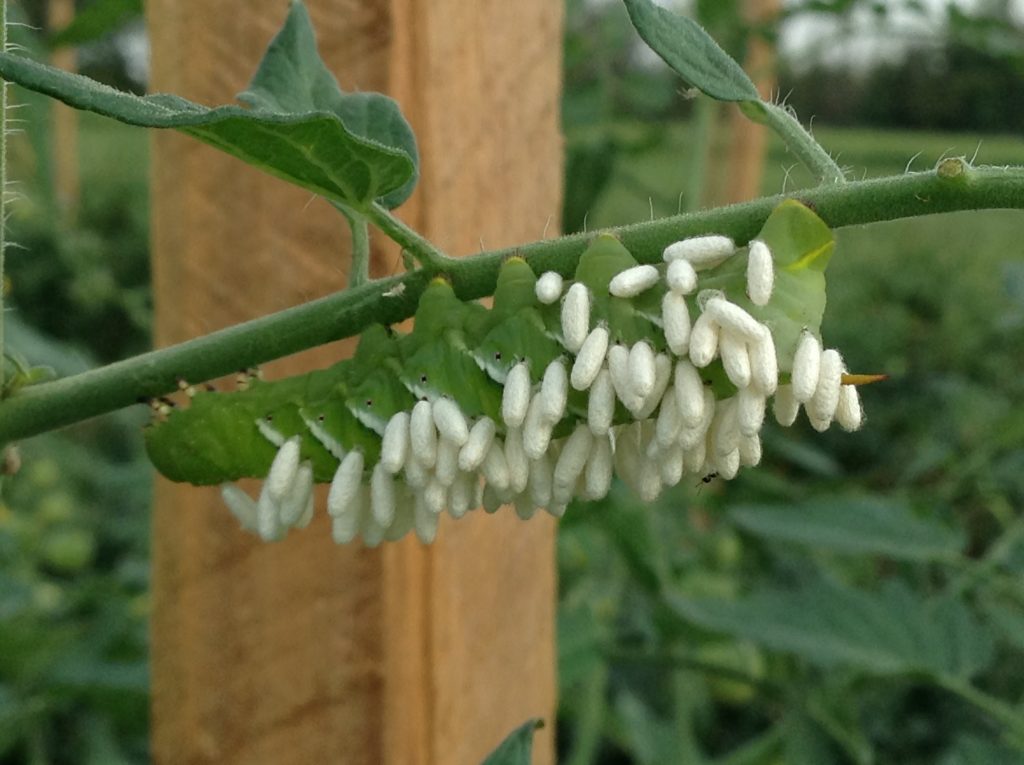
This is a tomato horn worm. It will devour our tomato plants. The white cylinders are actually the pupa of the Brachonid wasp larva, feeding on the insides of the worm.
Beneficial Insects — Sometimes we use the “circle of life” and rules of predator/prey to our advantage. For example, we know that the Brachonid wasp is a natural predator to the tomato horn worm. The female wasp lays its eggs in the body of the worm, and once they hatch, the larvae feed on the insides of the worm until it dies. We buy these wasp eggs and introduce them to our tomato fields at just the right time. It helps a TON.
Spraying the bugs — Wait, did you say “SPRAY?!!”…Yes.
So here’s the part of the blogpost where we bust the myth that organic farmers aren’t allowed to spray.
I assure you, organic farmers ARE legally allowed to spray chemicals on pests. But just certain kinds...
Specifically the kinds that are listed on the approved products list by OMRI (Organic Materials Review Institute). You can see this list here is you want… (We use Entrust, Pyganic, Azaguard most frequently). These OMRI approved products contain a type of naturally occurring biology that causes undesirable effects for the bug. For example, one variety might cause a bug’s exoskeleton to soften. Another disorients the metabolism of the pest so that they die.
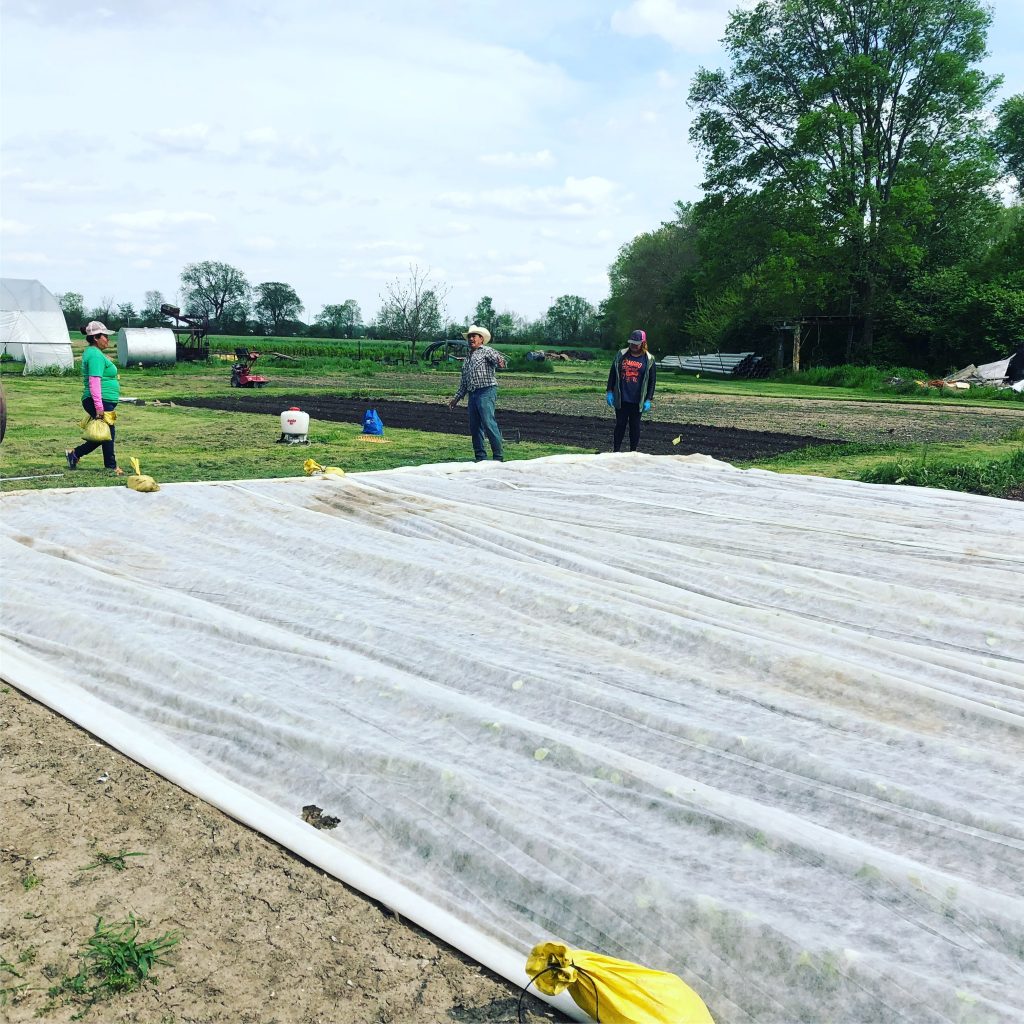
This is Agribon — row cover. We use it as as “shield” against the flea beetle.
Kurt scouts for pests on a regular schedule each week. He has learned to pay attention to certain threshold indicators that a pest may be getting out of control. We’ll place bright yellow sticky cards in the beds. The color attracts bugs; they get stuck to the card. And we count the population on the cards periodically to see how bad the pest pressure is. For example, when he notices more than say 5 plants in a given area contain thrips, he will know that he needs to spray to keep them from getting even more out of control.
We also spray fish emulsion and micro-biology/nutrients onto the soil before we ever even plant things. These kind of sprays are for building soil health — nothing to do with bugs.
As I said before, we must document every time we spray something — what we sprayed, how much concentration, which section of what row bed, what day and time, and keep a detailed log.
Can I tell you something?…
I rarely post a picture on Facebook of Farmer Kurt spraying our fields.
And that’s done intentionally. Not because I’m trying to hide it.
But because I don’t want it misinterpreted and taken out of context.
Perception is reality. And a completely legitimate application of fish emulsion or Pyganic could easily be taken for something else entirely to the untrained eye. And suddenly our branding takes an unfair hit.
So we’re just careful.
So if you run into someone else who believes the myth that organic farmers don’t spray… I want you to educate them.
Share with them some of the things you’ve learned in this article. We do a LOT of things to reduce the bug population.
Sometimes they work. Sometimes they don’t.
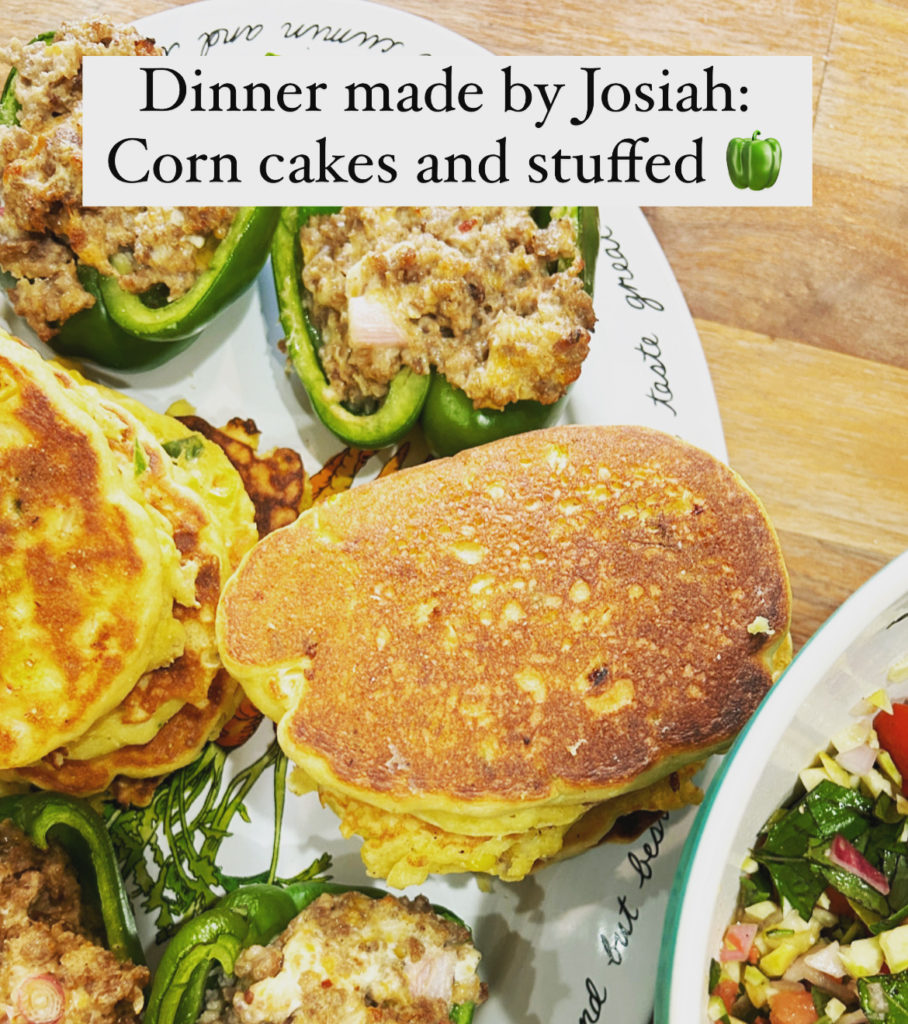
Josiah impressed us this Wednesday with a corn cakes and stuffed pepper dinner. Each of our boys has to make dinner once a week to learn how to cook. Sometimes we get really fun meals!
WEEK 8 CSA RECIPES
Members: You can download these recipes as a PDF here. These recipes are designed to inspire you to use your box this week! Please check inside our private Facebook group to find your fellow members sharing ideas for what to make with their box! Share a photo and you might be featured in next week’s newsletter!
Zucchini Noodle Salad with Parsley Pistachio Pesto
Zucchini Pizza Boats
Skillet Corn Medley with Peppers
Mexican Street Corn Salad with Creamy Spiced Dressing
5 Ingredient Cilantro Vinaigrette
Cilantro Lime Dip
Blistered Shishito Peppers
Blistered Shishito Peppers in the Air Fryer
Oregano Marinated Tomato Salad
Slow Cooked Stuffed Pepper Stew
Bell Pepper Tomato Salad
Breakfast Burritos (freezer meal)
Rosemary Potato Skillet with Bacon and Fresh Corn
Watermelon Caprese
Margarita Watermelon
Plum Salad with Black Pepper and Parmesan

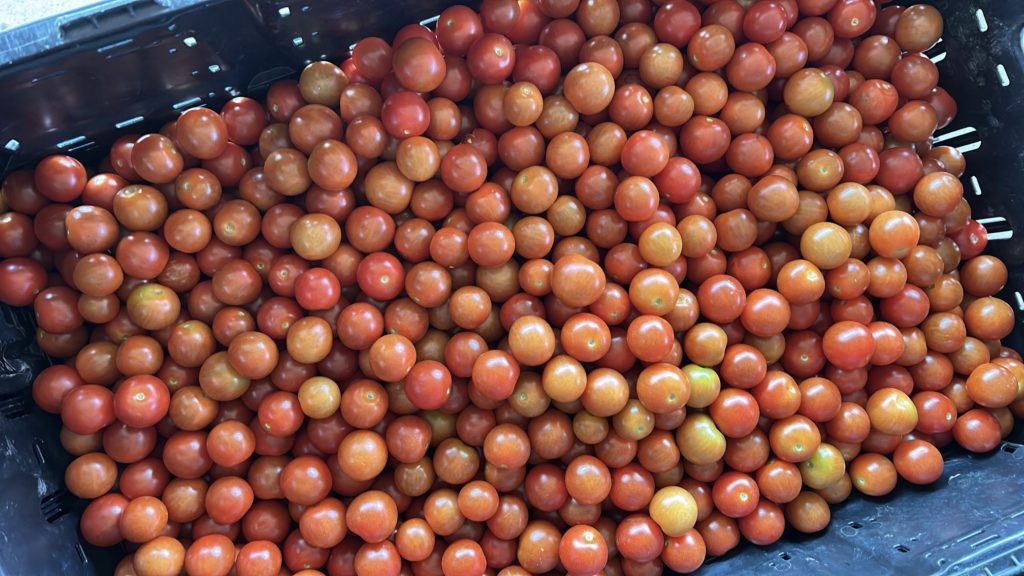

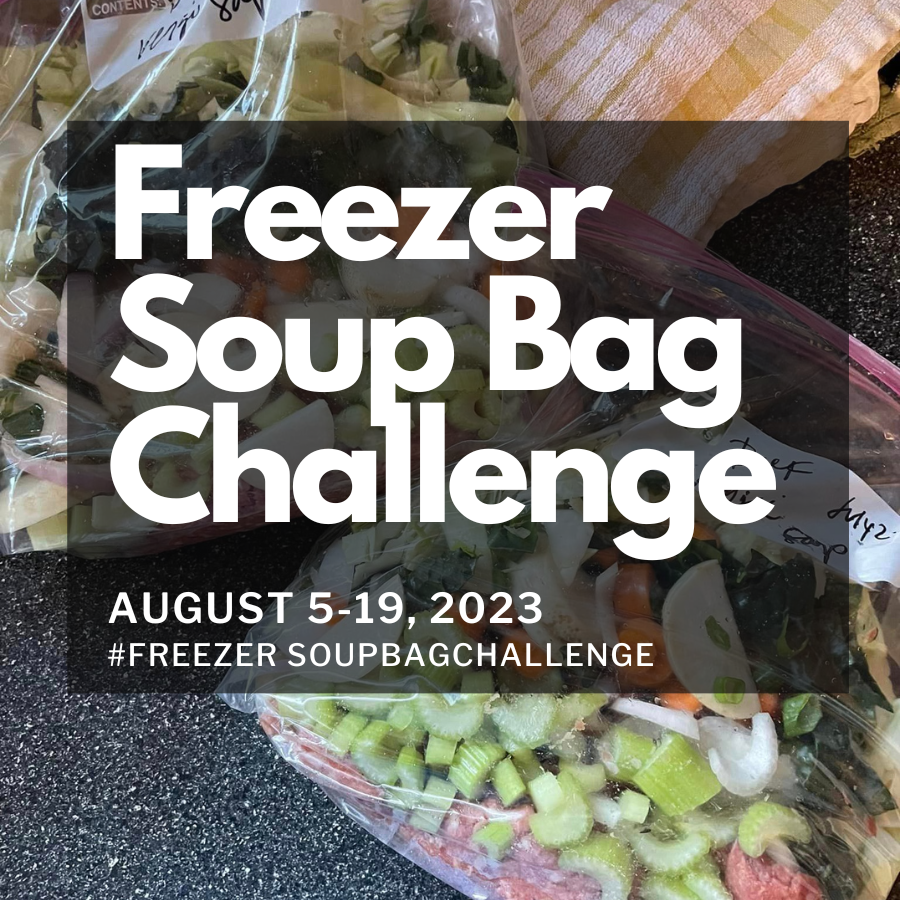 FREEZER SOUP STARTER BAG CHALLENGE!
FREEZER SOUP STARTER BAG CHALLENGE!